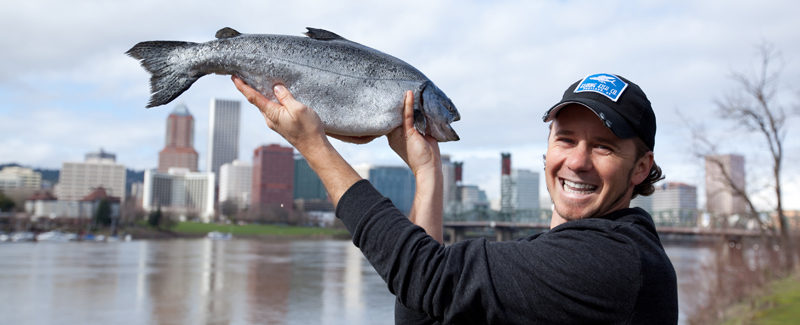Lyf and salmon with Portland in the background
Part I: The Providers
For those of us who catch, cook, or sell fish, National Seafood Month is a key time to reflect on how we’ve fared lately. In normal years we gather to celebrate what we’ve achieved and look back on what has changed. In a year like this, we fist bump our producers and our customers, and we write blog posts.
There’s lots to be thankful for, lots to honor and cherish, in this industry. In this two-part retrospective for National Seafood Month, I’m highlighting the ways in which the people who keep my business going came together in order to stay nourished and keep the celebration of the ocean’s bounty alive. First, I’ll use this space to honor the people who go to sea every day to catch the fish that I sell.
First and foremost, I am a fishmonger. I’ve been doing this for years, growing my business from a tent at a farmer’s market in Park City, Utah to a seafood shop and raw bar in a specialty market in Portland, Oregon to my own brick and mortar fish market called Flying Fish. It’s my life’s work to provide healthy and sustainable seafood to the people. It’s always been challenging. But the last 18 months have presented a type of challenge I never thought I would face. Thanks to the resilience of the small seafood supply chain model and the strength of the men and women who catch the fish I sell, we’re making it through this test.
Losing virtually every seafood restaurant in the country in March of 2020 created a void in the demand for seafood. Onsite dining was comatose. Fishermen, enjoying the strange new title “essential worker,” wanted to venture to the ocean to fish, but there was limited processing capacity to buy their product, and even more limited opportunities to get that product to consumers.
In the months that followed the initial downturn, some enterprising fishermen and their families found ways to sell their catch directly to consumers, instead of only selling to processors. Many of these business models were brand new to folks, while others expanded on their farmer’s market side hustle or their friends and family discounts.
Many fishing family spouses found themselves thrust into the role of part-time bookkeeper or municipal permit-gatherer, while simultaneously navigating childcare and the chaos we all experienced. Their dedication and strength can’t be praised loudly enough.
During this tumultuous time my ability to come through for my fishermen and buy their catch, when others turned up their nose, was key to continuing the strong relationships we have with them. When the bigger processors were evaluating their bottom lines, many decided to scale back or close cutting lines entirely because they lost their big accounts, without which they couldn’t keep going. Smaller markets like mine are not part of the equation for the bigger vertically integrated processors, because the big institutional buyers are required to keep high-overhead operations like that running.
The flip side of that coin is that the smaller operators who were able to scratch and scrape and create new markets, and those fishermen who already had or created access to direct sales, were the ones with the leg up. The smaller processors who could navigate labor shortages and ensure a healthy workplace for their employees got things moving again. The market pivot was tough on everyone, and it was a scramble at first, but as revenue began to flow, my partners were able to make ends meet again. And I loved seeing that.
My business relies on the relationships I have with fishermen and mom and pop processors, because their stewardship ethic and the stories they tell of catching seafood makes it all work. They’re my suppliers, and they’re my friends. And their care and motivation about the sustainability of the species they catch and process, and the environment their catch depends on, is what allows me to stand by the integrity of everything I sell in turn.
As the pandemic began to ease in the summer and early fall of 2020, it became clear that the sustainable seafood business model was going to be a resilient one. Bigger fillet lines and smaller processors alike began to move product as consumers began to rediscover what it means to cook seafood at home, how special that is. And when they come to me for their seafood, they can rely on me for sustainable products because I can rely on my suppliers in turn. We’ve learned what connects us throughout the supply chain, and we’ve been able to strengthen those key connections.
Thanks to the fishermen I buy from, we’re pulling through this, in many ways even more connected than before. Happy National Seafood Month to all of them!


